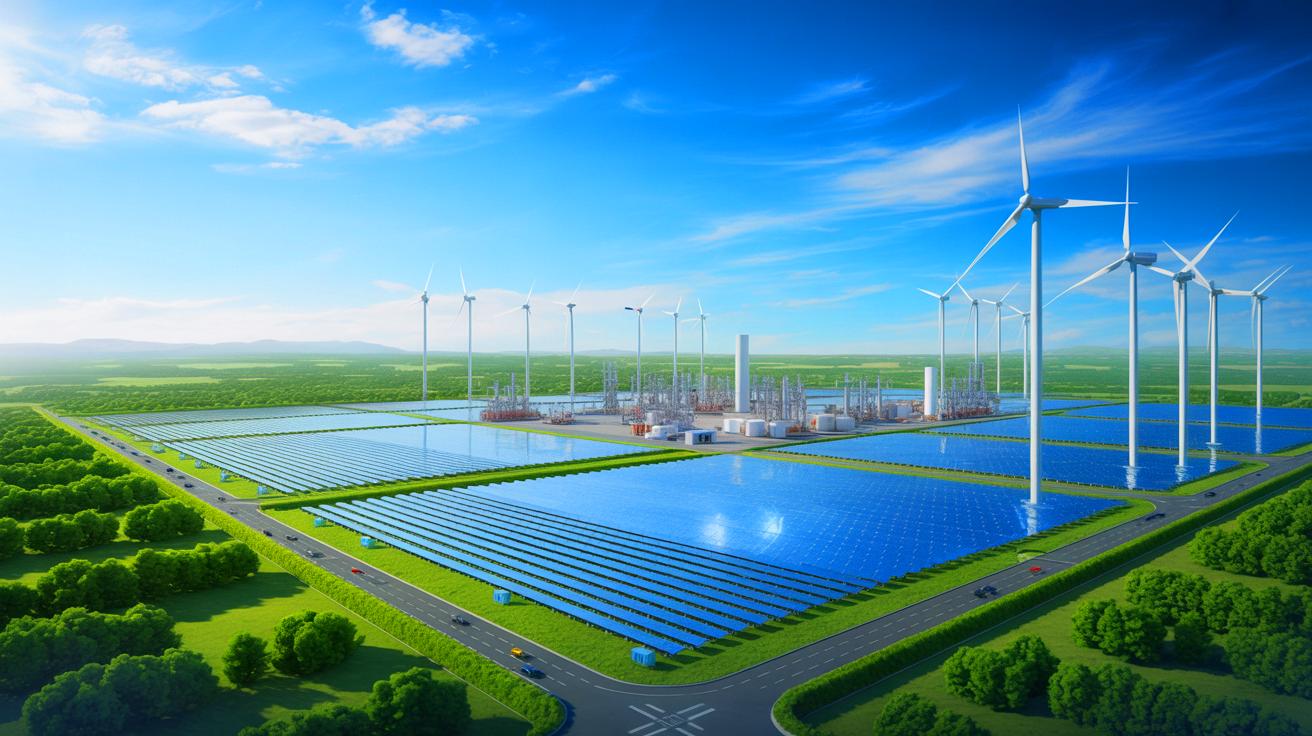Space Mirrors Are Coming: This Bold Solar Energy Project Aims to Beam Sunlight From Orbit Straight Into Photovoltaic Farms – Energy Reporters

Project Solspace: An Analysis of Space-Based Solar Reflectors and Their Alignment with Sustainable Development Goals
A research initiative by the University of Glasgow, known as Project Solspace, proposes the deployment of space-based reflectors to provide supplementary solar energy to terrestrial photovoltaic farms during nighttime. This report evaluates the project’s technical specifications, economic implications, and environmental considerations, with a significant emphasis on its potential contributions to the United Nations Sustainable Development Goals (SDGs).
Project Overview and Technical Specifications
Project Solspace aims to address the intermittency of solar power, a key challenge in achieving universal access to clean energy. The project’s alignment with SDG 9 (Industry, Innovation, and Infrastructure) is evident in its innovative approach to enhancing existing renewable energy infrastructure.
- Orbital Deployment: Satellites will be placed in a high heliosynchronous orbit, approximately 560 miles above Earth, to maintain a consistent angle relative to the sun.
- Reflector Design: Each satellite will feature a large, hexagonal mirror with sides measuring 820 feet, creating a total reflective surface of about 1.75 million square feet.
- Energy Delivery: The reflectors are designed to illuminate a 3.86 square mile area on Earth for approximately 17 minutes per pass. Each pass is projected to deliver between 34 and 36 megawatt-hours of additional energy.
Advancing Global Sustainability Targets
The core objective of Project Solspace directly supports several key SDGs, positioning it as a potentially transformative technology in the global effort towards sustainability.
Contribution to SDG 7 and SDG 13
The project’s primary impact lies in its potential to advance SDG 7 (Affordable and Clean Energy) and SDG 13 (Climate Action).
- Enhanced Clean Energy Access: By enabling solar farms to generate power after sunset, the technology increases the reliability and output of a key renewable source, reducing dependence on fossil fuels, especially during peak demand hours.
- Climate Change Mitigation: A more efficient and consistent solar energy supply chain directly contributes to lowering greenhouse gas emissions, a central goal of global climate action initiatives.
Supporting SDG 9 and SDG 11
The initiative also represents a significant step forward for SDG 9 (Industry, Innovation, and Infrastructure) and SDG 11 (Sustainable Cities and Communities).
- Fostering Innovation: Solspace is a frontier project that pushes the boundaries of aerospace and energy technology, building upon historical precedents like the 1993 Znamya project but leveraging modern cost reductions in space launches.
- Building Sustainable Communities: A consistent supply of clean energy can lower electricity costs and improve energy security for urban populations, making cities more resilient and sustainable.
Challenges and Environmental Considerations
While the project promises significant benefits, a comprehensive assessment must include potential environmental and social challenges, particularly concerning SDG 15 (Life on Land).
Ecological Impact Assessment
The introduction of a significant artificial light source during nighttime raises critical questions that require thorough investigation before large-scale deployment.
- Disruption of Ecosystems: The project could potentially disrupt nocturnal wildlife and local ecosystems that depend on natural cycles of light and darkness.
- Need for Balanced Stewardship: A critical challenge will be to balance technological advancement with environmental stewardship, ensuring that the pursuit of clean energy does not inadvertently harm biodiversity. This necessitates comprehensive environmental impact studies as part of the project’s development.
Economic and Social Viability
The commercial success of Project Solspace is contingent on continued reductions in space mission costs, driven by private sector innovation. Achieving this will require robust public-private partnerships, aligning with SDG 17 (Partnerships for the Goals), to ensure the technology becomes both economically feasible and equitably distributed.
1. Which SDGs are addressed or connected to the issues highlighted in the article?
The article on Project Solspace discusses issues and innovations that are directly and indirectly connected to several Sustainable Development Goals. The analysis identifies the following SDGs:
- SDG 7: Affordable and Clean Energy: The core focus of the article is on a new technology to enhance solar energy production, making it more reliable and consistent. This directly aligns with the goal of ensuring access to affordable, reliable, sustainable, and modern energy for all.
- SDG 9: Industry, Innovation and Infrastructure: The project is described as a “groundbreaking initiative” involving advanced aerospace technology and innovative engineering from the University of Glasgow. It represents a significant advancement in scientific research and aims to create a more resilient energy infrastructure.
- SDG 13: Climate Action: A key benefit highlighted in the article is the potential to “reduce reliance on fossil fuels.” By increasing the efficiency and availability of solar power, a clean energy source, the project contributes to mitigating climate change.
- SDG 15: Life on Land: The article explicitly raises concerns about the environmental impact of the project, noting that “artificial light sources at night could have unforeseen effects on local ecosystems and wildlife, which rely on natural light cycles.” This connects the project to the goal of protecting terrestrial ecosystems and biodiversity.
2. What specific targets under those SDGs can be identified based on the article’s content?
SDG 7: Affordable and Clean Energy
- Target 7.2: By 2030, increase substantially the share of renewable energy in the global energy mix.
- Explanation: The article states that Project Solspace promises to “enhance renewable energy efficiency.” By providing sunlight to solar farms at night, the project directly aims to increase the output from a renewable source, thereby increasing its share in the energy mix.
- Target 7.a: By 2030, enhance international cooperation to facilitate access to clean energy research and technology… and promote investment in energy infrastructure and clean energy technology.
- Explanation: Project Solspace, developed by researchers at the University of Glasgow, is a prime example of “clean energy research and technology.” The article notes that the project’s commercial viability is increasing as private companies like SpaceX reduce space mission costs, implying a synergy between research and industry to advance clean energy infrastructure.
SDG 9: Industry, Innovation and Infrastructure
- Target 9.4: By 2030, upgrade infrastructure and retrofit industries to make them sustainable, with increased resource-use efficiency and greater adoption of clean and environmentally sound technologies.
- Explanation: The project is a “clean… technology” designed to upgrade existing energy infrastructure (solar farms) by making them more efficient. The article states that “the efficiency of solar farms could be substantially increased,” which directly relates to increased resource-use efficiency.
- Target 9.5: Enhance scientific research, upgrade the technological capabilities of industrial sectors in all countries… and encouraging innovation.
- Explanation: The article highlights the project as a “groundbreaking initiative” from the University of Glasgow. This represents the enhancement of scientific research and innovation in the energy and aerospace sectors.
SDG 13: Climate Action
- Target 13.2: Integrate climate change measures into national policies, strategies and planning.
- Explanation: While not a policy itself, Project Solspace is a technological strategy aimed at climate change mitigation. The article emphasizes that the technology helps “reduce dependency on fossil fuels,” which is a core component of climate action strategies worldwide.
SDG 15: Life on Land
- Target 15.5: Take urgent and significant action to reduce the degradation of natural habitats, halt the loss of biodiversity…
- Explanation: The article directly addresses this target by raising a crucial concern: “The introduction of artificial light sources at night could have unforeseen effects on local ecosystems and wildlife, which rely on natural light cycles.” This highlights the need to assess and mitigate potential harm to natural habitats and biodiversity before deploying such technology.
3. Are there any indicators mentioned or implied in the article that can be used to measure progress towards the identified targets?
Indicators for SDG 7
- Indicator related to Target 7.2: The article provides a specific metric for the additional energy that could be generated. It states that “each reflector could deliver between 34 and 36 megawatt-hours of additional energy per pass.” This quantifiable amount can be used to measure the increased contribution of solar energy to the total energy supply.
- Indicator related to Target 7.1 (Affordability): The article implies an economic indicator by mentioning that “communities could benefit from lower electricity bills” and industries could see “a decrease in operational costs.” Measuring changes in electricity prices in areas served by this technology would be a relevant indicator.
Indicators for SDG 9
- Indicator related to Target 9.4: Progress can be measured by the “efficiency of solar farms.” The article states this could be “substantially increased.” A specific indicator would be the percentage increase in the capacity factor of solar farms benefiting from the reflectors.
- Indicator related to Target 9.5: The existence of “Project Solspace” itself serves as an indicator of investment in research and development for clean technology. The decreasing “costs of space missions” mentioned in the article is another quantifiable indicator that makes such innovative projects more feasible.
Indicators for SDG 13
- Indicator related to Target 13.2: The primary indicator is the “reduc[tion in] reliance on fossil fuels.” This can be measured by tracking the displacement of fossil fuel-based power generation (in megawatt-hours) by the additional solar energy produced via the reflectors.
Indicators for SDG 15
- Indicator related to Target 15.5: The article implies the need for a specific indicator by calling for a “comprehensive evaluation of the project’s environmental impact.” A relevant indicator would be the measured “effects on local ecosystems and wildlife,” which could be assessed through biodiversity surveys and studies on animal behavior in the illuminated areas.
4. Table of SDGs, Targets, and Indicators
| SDGs | Targets | Indicators Identified in the Article |
|---|---|---|
| SDG 7: Affordable and Clean Energy | 7.2: Increase substantially the share of renewable energy in the global energy mix. | The amount of additional energy delivered per pass (34-36 MWh), contributing to the renewable energy share. |
| SDG 9: Industry, Innovation and Infrastructure | 9.4: Upgrade infrastructure… with increased resource-use efficiency and greater adoption of clean… technologies. | The substantial increase in the “efficiency of solar farms.” |
| 9.5: Enhance scientific research… and encouraging innovation. | The development of “Project Solspace” as an example of advanced research; decreasing costs of space missions enabling innovation. | |
| SDG 13: Climate Action | 13.2: Integrate climate change measures into… strategies and planning. | The “reduc[tion in] dependency on fossil fuels” as a direct outcome of the technology. |
| SDG 15: Life on Land | 15.5: Take urgent and significant action to reduce the degradation of natural habitats… | The need for an “environmental impact” evaluation to measure the “unforeseen effects on local ecosystems and wildlife.” |
Source: energy-reporters.com

What is Your Reaction?
 Like
0
Like
0
 Dislike
0
Dislike
0
 Love
0
Love
0
 Funny
0
Funny
0
 Angry
0
Angry
0
 Sad
0
Sad
0
 Wow
0
Wow
0











































































